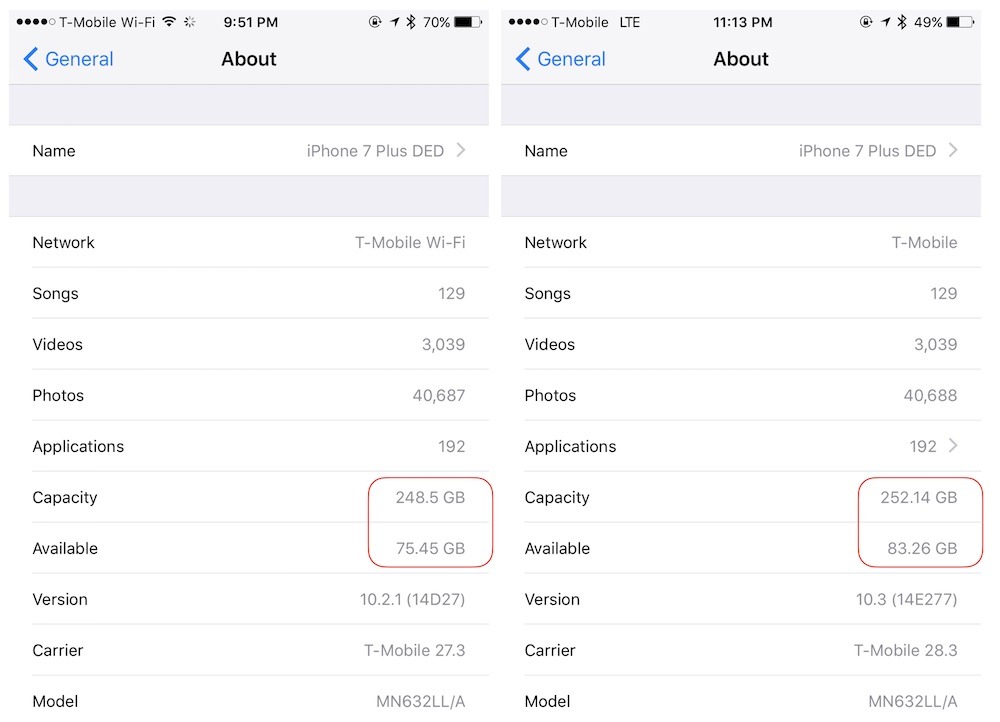While the feature enhancements of new OS updates generally take up more of your available storage, Apple's latest iOS 10.3 update has freed up gigabytes of available storage for many users making the upgrade. It reclaimed as much as 7.81 GB in our testing.
After upgrading a top of the line, 256GB iPhone 7 Plus (packed with over 40,000 photos and almost 200 apps) from iOS 10.2.1 to 10.3, the phone reported a jump in available space from 75.45 GB to 83.26 GB, an increase of 7.81 GB.
Curiously, the device also reported an increase in capacity, which jumped from 248.5 GB to 252.14 GB, a difference of 3.64 GB.
Capacity isn't just a measure of the hardware memory bits on the chips the device uses for storage; the OS also subtracts away some "capacity" allocated to the EFI partition map and other low-level storage overhead. The larger the storage of your device, the more free space iOS 10.3 appears able to reclaim.
APFS
It appears that the conversion to the new Apple File System (APFS) included in iOS 10.3 is more efficient in how it formats volume storage. APFS was designed specifically to take advantage of modern "solid state" storage technology (as opposed to the spinning magnetic disk hard drives of the era when Apple's previous HFS+ file system was developed). It also allows for much larger storage devices in the future, via its support for 64-bit file system structures.
Among the features of the new file system (which organizes how data is written, on a low level) is a new volume partitioning scheme that allows for flexible expansion. This appears to also result in a capacity increase, consuming less storage as part of the volume partition and file system structure. The iOS 10.3 update appears to take a bit longer than usual, in part due to the in-place update to APFS it includes. Depending on the device involved, the update may require 30-50 minutes.
Above the low-level partition map, APFS also includes support for new storage-saving features. One example is "clones," which let the file system create an identical copy of a file without taking up additional space, by referencing the same storage structure as representing multiple files in different locations.
It's possible that iOS and third-party apps will increasingly take further advantage of APFS features to save even more space in the future, optimizing their storage practices to match the capabilities of the underlying file system.
In addition to enhancements related to the new APFS, iOS 10.3 may also be optimizing higher level features of data storage, such as flushing cached data (used in streaming, for example) and dumping other unnecessary files. As with previous iOS versions, users can also optimize their storage by uploading full quality photos to iCloud and keeping mobile optimized versions on their phone.
Whatever the exact causes for the reported capacity increases, users will be happy to see increased available storage for their photos and other content on top of the new features added to iOS 10.3, including new features for Siri, support for locating lost AirPods, new CarPlay features and a revamped Settings app that centralizes user-related information related to passwords, devices and iCloud, App Store and Family Sharing accounts.
 Daniel Eran Dilger
Daniel Eran Dilger


-m.jpg)






 Marko Zivkovic
Marko Zivkovic
 Mike Wuerthele
Mike Wuerthele
 Christine McKee
Christine McKee
 Amber Neely
Amber Neely
 Wesley Hilliard
Wesley Hilliard

 William Gallagher
William Gallagher










42 Comments
Yep, I got back 3Gb on a nearly full 64Gb iphone 6 after the upgrade
I'd say I got about 2 gigs on a 32 gb ipad pro. That's a welcome surprise!
Ha! Perhaps Apple can modify the warning on their website now that was required after CapacityGate.
"1. Available space is less and varies due to many factors. A standard configuration uses approximately 4GB to 6GB of space (including iOS and built-in apps), depending on the model and settings".
I'm hoping that the across the board (MacOS hasn't yet rolled this out yet) APFS rollout will result in Apple finally putting in place a file handling system across Apple's entire line of products.